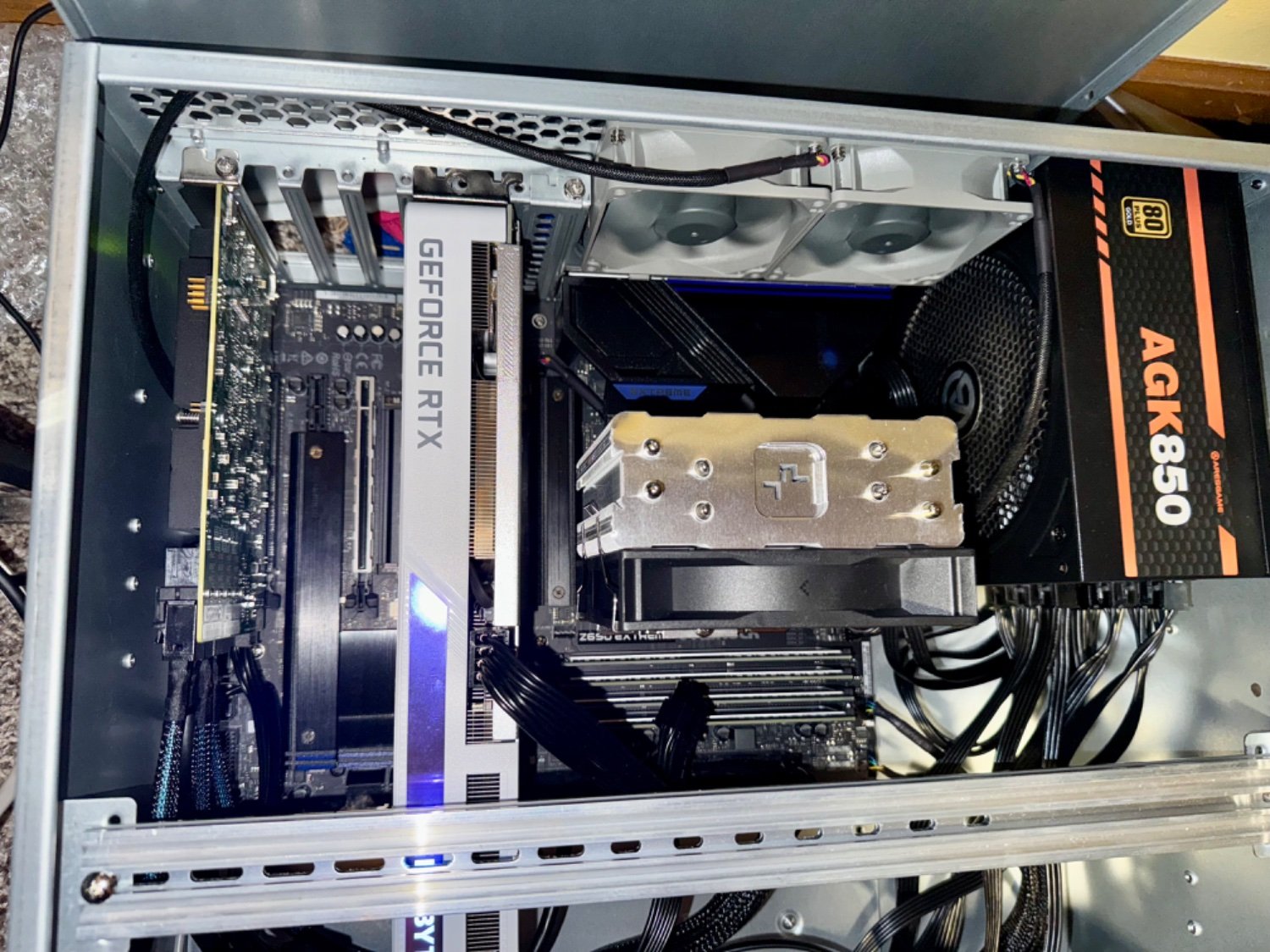Like the title says. I installed a GPU, everything posts and boots fine. The lights on the Ethernet port are lit up and will stay lit up indefinitely (I assume) if I leave it at the kernel select screen.
But as soon as I load a kernel, the lights go dark. It also is not shown as an active client on my gateway, so it’s not working at all.
I’ve tried lots of commands I’ve found to force it up. It looks to me like the NIC assigned to vmbr0 is correct. Etc. I just can’t get it to work.
If I remove the GPU, it immediately works again. NIC stays up after the kernel loads and I can access the web UI as normal.
rooteprox. *
root@prox:*# ip a
- 10: «LOOPBACK, UP,LOWER_UP> mtu 65536 qdisc noqueue state UNKNOWN group default qlen 1000
link/loopback 00:00:00:00:00:00 brd 00:00:00:00:00:00
inet 127.0.0.1/8 scope host lo
valid_lft forever preferred_lft forever
inet6 :: 1/128 scope host noprefixroute valid_lft forever preferred_lft forever - enpsso: ‹BROADCAST, MULTICAST> mtu 1500 qdisc noop state DOHN group default qlen 1000 link/ether a8:a1:59:be:f2:33 brd ff:ff:ff:ff:ff:ff
enp0s31f6: «NO-CARRIER, BROADCAST, MULTICAST, UP> mtu 1500 qdisc pfifo_fast master vmbro state DOWN group default qlen 1000 link/ether a8:a1:59:be:f2:32 brd ff:ff:ff:ff:ff:ff
vmbrO: ‹NO-CARRIER, BROADCAST, MULTICAST, UP> mtu 1500 qdisc noqueue state DOWN group default qlen 1000 link/ether a8:a1:59:be:f2:32 brd ff:ff:ff:ff:ff:ff
inet 192.168.1.3/24 scope global vmbro valid_lft forever preferred_lft forever
root@prox: *# cat /etc/network/interfaces
auto lo
iface lo inet loopback
iface enp0s31f6 inet manual
auto vmbro
iface vmbro inet static
address 192.168.1.3/24
gateway 192.168.1.1
bridge-ports enp0s31f6
bridge-stp off bridge-fd o
iface enps0 inet manual
source /etc/network/interfaces.d/*
root@prox: ~# service network restart
Failed to restart network.service: Unit network.service not found.
Check what changes in
lspcicommand between not having the GPU connected vs. Having it connected.I am suspecting that your PCI-E bandwidth is getting exhausted once the kernel activates your GPU.
Edit: Although I could be wrong about this. So makes sense to try passing “nomodeset” to your kernel parameters and see if that changes anything.
Ok. I’ll check it out.
Let’s say it is exhausted… what will get me more bandwidth? CPU or mobo…?
Only other pci-e card in at the moment is 16 line HBA seems to be basically 2 cards sandwiched on one board)…
Possible something on your motherboard has PCIe lanes that are dedicated to GPU when it’s slotted, otherwise they can be used for other devices?
For example here’s a post about m.2 slots that, when used, affect the PCI on a particular board. May be worth checking your boards manual to see if there’s something similar.
The answer not only seemed a HUGE disappointment, but a bit baffling. The pdf manual says if you occupy that 5th m.2 slot, which is the Gen 5 one, the Pci-E 1 slot is automatically downgraded to 8x. This I thought would be unacceptable if running a behemoth like the RTX 4090 I eventually plan to get, as it requires a lot of power and bandwidth.
Try disconnecting everything including the extra board.
It’s late. I’ll have to pull the card and re run tomorrow. But here’s with the GPU in:

It’s an i7-14700 and an ASRock z690 extreme. I’m actually hoping to put a second GPU in the last PCIe slot so I can let proxmox use the iGPU, pass the 3060 into a Unix moonlight gaming VM, and pass an RX590 into a hackintosh VM.

I had an issue with an ASrock Tiachi where if I enabled virtualization, the network would disappear entirely. May want to check for FW updates for your board. I had nothing but issues with the shitty BIOS and even had to upgrade my CPU sooner than I wanted to do the update.
Make sure your CPU is still supported by the update.
Aren’t the PCIe lanes directly connected to the CPU? So the connections would be rerouted in hardware to connect to the GPU?
I am not the poster but I am curious if you know what maybe happening on a hardware level.
Like others have said you may be running out of PCIe lanes. If that isn’t the problem and this is a software bug you could try blocklisting the GPU kernel module.
Is the NIC built into the motherboard or an add on pcie card?
You could check the journal to see if the logs tell you anything.
ASRock Z90 Extreme.
Has 2 built in NICs. The intel 1g and the Broadcom 2.5g.
Trying to use the Broadcom here, though my Ethernet is only 1g house wide, so I could try the intel if that seems like it could help…
I don’t think you’ll benefit at all from using the 2.5Gbit port if you only have 1Gbit cables, so there’s no downside
check
lsmodbefore and after see what kernel modules are changing.also look at
dmesgfor interesting kernel messages as you attempt to use / not use the offending hardware.I had a stock Debian install actually rename the device for my NIC when I changed GPUs. You should double-check if your NIC has the same entry in /dev with and without the GPU. After I changed the name in some config files the NIC worked fine with the GPU in, it could be easy as that.
I read through your screenshot. The ip command has enp3s0 and the config has enp2s0, I think this might be it.
deleted by creator






